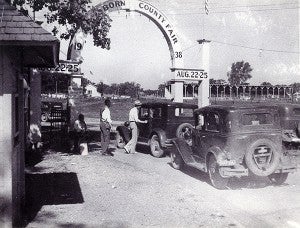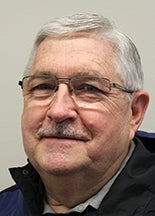History of the Freeborn County Fair
Published 9:00 am Sunday, July 20, 2014
History Revisited by Jerome Meyer
The annual Freeborn County Fair is rapidly approaching for the 2014 season. The six days and nights of the fair just don’t happen during the fair days. The county fair planning and preparations are a yearlong process with the Freeborn County Agriculture Society President Gordon Toenges, General Manager Norman Fredin, the fair board officers and directors, the county commissioners and volunteers all putting in many long hours of work for the 131st county fair.
This year the fair board is hoping to top the 2013 fair attendance of 95,000 people, which is in the top five for Minnesota county fairs.
Probably one of the last items the fairgoers think about when they go through the fair entrance gates are the 150-plus years of history of the local fair. We may think that the Freeborn County Fair has been about the same over all these years. This is far from the truth. Past history will show that the Freeborn County Fair had a very humble, unstable and challenging beginning through the early years.
If you look up the combined words of “county and fair,” Webster’s dictionary describes them as: a small, local administrative district in a state holding a festival with entertainment, exhibitors — often competitive, featuring farm, household and manufactured products with various amusement and food facilities. This mouthfull description of a county fair is basically the structure of the current Freeborn County Fair even though the fair has evolved from a very simple beginning over many years to its current state.
The Freeborn County Fair’s history dates back to 1859, a year after Minnesota became a state, when the Freeborn County Eagle announced that the farmers of Freeborn County were to meet on Wednesday, Jan. 5, at 1 p.m. for the purpose of organizing a County Agricultural Society — with the purpose of stimulating the drooping spirits of farmers, develop and promote the agricultural resources and mechanical arts of the county and improving the poor current farm economy. Citizens who joined the society were to sign the constitution and pay a membership fee of 50 cents annually. The constitution consisting of 11 sections was published for the public’s viewing in the Freeborn County Standard in August of 1860.

The Freeborn County Fair was lively, as pictured in this photo of the fair gate in 1938. – Photo courtesy of the Freeborn County Historical Museum
The first two Freeborn County Fairs were promoted by the County Agricultural Society and were in 1859 and 1860. Thus, you can say that the Freeborn County Fair was started by farmers. Little, if any, historical information was recorded on these two fairs so we don’t know what really happened. Probably there was no resemblance to today’s county fair with no Midway, no hot dog stands, no bingo and no Grandstand, just to name a few.
The Freeborn County Fair for the first 45 years was in many county/city locations with some of the first fairs taking place on Albert Lea’s Main Street. Then in 1903, the Freeborn County commissioners purchased 45 acres resulting in the current location of the fairgrounds for $5,450.
The early days of the fair were only in the daytime as there was no electricity available at that time. One report stated that only the animal barns containing horses and cattle where exhibits stayed had kerosene lanterns for their night light.
If you do the math, it will tell you that the Freeborn County Fair was not held each year since 1859. There were no fairs held from 1861 to 1868 because of the Civil War, no fairs from 1879 to 1889 and no fairs from 1896 to 1900. The 1903 fair was canceled because of extreme rain showers and the 1946 fair canceled because of the local polio epidemic.
Unable to put into text all of the history for the 150-plus years of the Freeborn County Fair, it’s interesting to highlight some of the interesting historical items that were reordered over the various years.
1870: A family ticket was $1. There were awards for the best-made leather shoes and 15 prizes for the best wine exhibit samples.
1872: The fair board staged a dancing party at the county courthouse location.
1873: The fair was at Central Park. The fair reorganized as the Farmers Club.
1878: The telephone was exhibited for the first time as a new invention. A completely stuffed buffalo was displayed to show its actual size. Total fair receipts were $340 with $328.26 in expenses.
1889: After much debate, consideration and a general election from the people of Freeborn County, the county residents voted in favor of holding the fair again after 10 years of slumbering. No grounds or buildings for this fair were available and only $200 were in the county fair bank account. The fair was held on Dr. Wedge’s land on his Oak Ridge Farm.
1903: The fair was rained out on Monday because of a continued 24-hour rain. Very bad county and township roads prevented people from traveling. Admission was listed at 25 cents. Horse racing was held later in the week. County commissioners announced the purchase of 45 acres of land where the current fair is now located through a special act of the Minnesota Legislature, and $6,000 were approved for fairground improvements involving a fence surrounding the grounds, half-mile racetrack and several new exhibit buildings.
1904: It became the first fair in Minnesota held on grounds owned and equipped at public expense. With no night fair at that time, fair entertainment was held on three platforms at various intersections in Albert Lea along Broadway, as the street had lights at that time.
1913: A band concert featured the Wells Maroon Band. Free admission for all trot and pace horse races and motorcycle races — five and 10 miles. A spelling contest is held in the Floral Hall.
1914: It was the first time opening evenings for the fair. The new Grandstand featured single and twin cylinder motorcycle races with Indian and Excelsior brands. Winners received prize money between $30 and $60 for the various racing categories. Twenty-five thousand people attended the fair on Thursday and Friday.
1920: Seventy-six horses entered for three days of racing. That was the largest number of entries ever received in Minnesota outside of the State Fair.
1933: Wrestling events were held for entertainment, or, as some called, it “rasseling.” The featured wrestler was a Minnesota native Bronko Nagurski — a former University of Minnesota football player and a professional football fullback with the Chicago Bears. Admission was 40 cents for gents and 25 cents for ladies and children.
1935: Attendance was 75,000 with gate receipts of $11,386.25. The old Midway became known as Machinery Hill. Gate admission was 25 cents. A new 1935 Ford V-8 was to be given away at the Grandstand. Each ticket for admission had a number for the free-car drawing. Season tickets were $1.
1936: It was the first time for mule races. Races advertised as a free-for-all. Age limit of mules was from 2 to 50 years old. Riders had to be of sound mind, under 75 years old and ride at your own risk.
Fair entertainment was and is one of biggest attractions for the annual event. Horse racing was the featured Grandstand event and most popular one in the late 1800s to the 1950s.
Stock car racing was also popular in the 1940s to the early 1970s. Some of the area racers were Rex Gar, Wyeth (Buddy Paul) Anderson and Ole Brua from Albert Lea, Floyd Malter of Lyle and Earl Scott of Austin. The 1965 fair advertised the stock car races featuring 30 to 35 cars with many local drivers and drivers from the Upper Midwest belonging to the Minnesota State Stock Car Racing Inc. Racing prizes totaled $1,200 for each of the two nights of racing plus cash bonuses were given out to the race winners.
The Freeborn County Fair is best known for its Grandstand attractions of musical artists over the years — being featured mostly for its country music entertainers. Over the years such popular names of George Jones, the Oak Ridge Boys, Mickey Gilley, Charlie Pride, Alabama and Roy Clark have been Grandstand headliners, just to name a few.
Maybe, just maybe, it you drive into the empty Freeborn County Fairgrounds some quiet summer evening, turn down the car radio, roll the windows down, drive slow and you may hear in the distance the faint echo of the fair crowd noise or the old-time Midway barker hollering to the crowd that for just 25 cents they can see the Elephant Man in the big tent, possibly the distant roaring sound of the stock cars circling the race track with just a little track dust floating in the air or maybe just the whiff of a foot-long hot dog. Or if you turn your ears toward the Grandstand stage and really listen very closely, you may hear the low whisper of Hank Williams Jr. singing “Your Cheatin’ Heart,” George Jones singing “White Lightning” or the Oak Ridge Boys singing “Elvira.”
Jerome Meyer likes to write about local history.
Information was obtained from Albert Lea Tribune papers collected by the Freeborn County Fair office, with research done by Roger Lonning. The photos were given by the permission of the Freeborn County Historical Museum. Also information was obtained from Norman Fredin, the fair’s general manager.





